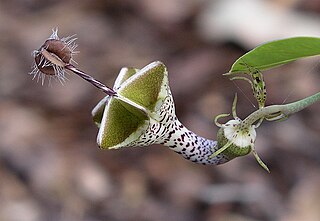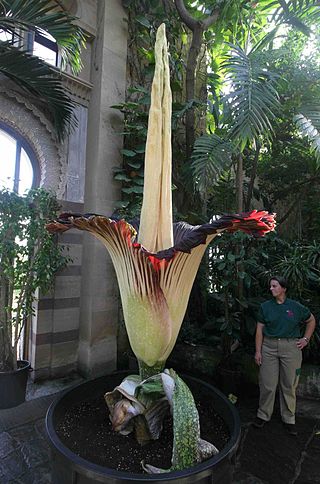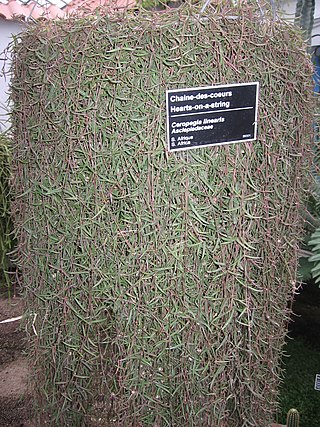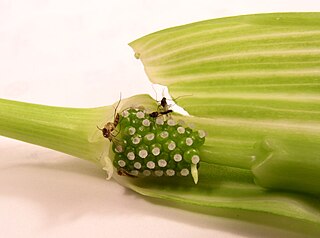
Apocynaceae is a family of flowering plants that includes trees, shrubs, herbs, stem succulents, and vines, commonly known as the dogbane family, because some taxa were used as dog poison. Members of the family are native to the European, Asian, African, Australian, and American tropics or subtropics, with some temperate members. The former family Asclepiadaceae is considered a subfamily of Apocynaceae and contains 348 genera. A list of Apocynaceae genera may be found here.

Ceropegia is a genus of plants within the family Apocynaceae, native to Africa, southern Asia, and Australia. It was named by Carl Linnaeus, who first described this genus in his Genera plantarum, which appeared in 1737. Linnaeus referred to the description and picture of a plant in the Horti Malabarici as the plant for which the genus was created. In 1753 he named this species as Ceropegia candelabrum. Linnaeus did not explain the etymology but later explanations stated that the name Ceropegia was from the Greek word keropegion κηροπηγɩον. This means candelabrum in Latin, which has a broader range than the modern word - "a candlestick, a branched candlestick, a chandelier, candelabrum, or also lamp-stand, light-stand, sometimes of exquisite workmanship".

Stapeliinae is a subtribe of flowering plants within the tribe Ceropegieae of the subfamily Asclepiadoideae of the family Apocynaceae. The subtribe comprises about 35 genera, including both the stem-succulent "stapeliads" and the horticulturally popular genera Brachystelma and Ceropegia. The largest number of genera are native to Africa, but a more limited number of genera are widespread in Arabia and Asia. Historically, a similarly circumscribed taxon was treated as a separate tribe, Stapelieae.

Carrion flowers, also known as corpse flowers or stinking flowers, are mimetic flowers that emit an odor that smells like rotting flesh. Apart from the scent, carrion flowers often display additional characteristics that contribute to the mimesis of a decaying corpse. These include their specific coloration, the presence of setae and orifice-like flower architecture. Carrion flowers attract mostly scavenging flies and beetles as pollinators. Some species may trap the insects temporarily to ensure the gathering and transfer of pollen.

Ceropegia woodii is a flowering plant in the dogbane family Apocynaceae, native to South Africa, Eswatini and Zimbabwe. It is sometimes treated as a subspecies of the related Ceropegia linearis, as C. linearis subsp. woodii. Common names include chain of hearts, collar of hearts, string of hearts, rosary vine, hearts-on-a-string, and sweetheart vine.

Banksia paludosa, commonly known as the marsh or swamp banksia, is a species of shrub in the plant genus Banksia. It is native to New South Wales, Australia, where it is found between Sydney and Batemans Bay, with an isolated population further south around Eden. There are two recognised subspecies, the nominate of which is a spreading shrub to 1.5 m (4.9 ft) in height, and subsp. astrolux is a taller shrub to 5 m (16 ft) high found only in Nattai National Park.

Stapelia gigantea is a species of flowering plant in the genus Stapelia of the family Apocynaceae. Common names include Zulu giant, carrion plant and toad plant. The plant is native to the desert regions of South Africa to Tanzania.

Adenium obesum, more commonly known as a desert rose, is a poisonous species of flowering plant belonging to the tribe Nerieae of the subfamily Apocynoideae of the dogbane family, Apocynaceae. It is native to the Sahel regions south of the Sahara, tropical and subtropical eastern and southern Africa and also the Arabian Peninsula. Other names for the flower include Sabi star, kudu, mock azalea, and impala lily. Adenium obesum is a popular houseplant and bonsai in temperate regions.

Robert Allen Dyer was a South African botanist and taxonomist, working particularly on Amaryllidaceae and succulent plants, contributing to and editing of Bothalia and Flowering Plants of Africa and holding the office of Director of the Botanical Research Institute in Pretoria from 1944 to 1963.

Ceropegia sandersonii is a species of flowering plant in the family Apocynaceae that is native to Mozambique, South Africa, and Eswatini. Common names are parachute plant, fountain flower, and umbrella plant.

Cynanchum viminale is a leafless succulent plant in the family Apocynaceae. The species is native to West Africa, the Indian Ocean and Western Pacific region. The species' natural range extends from South Africa throughout much of Africa and the Middle East to India, Indochina, Southern China, Indomalaya and into Meganesia. The species is also found on several Indian Oceans islands including Mauritius, Réunion and the Seychelles.

Microloma is a small genus of Ceropegia-like twiners and twiggy bushes occurring in mainly arid or fynbos regions in South Africa. They are generally nondescript when not in bloom, but the flowers of most species are incongruously decorative.

Ceropegia linearis is a species of flowering plant in the family Apocynaceae, native to Southern Africa.

Vexatorella is a genus containing four species of flowering plant, commonly known as vexators, in the family Proteaceae. The genus is endemic to the Cape Floristic Region of South Africa. The name means “little trouble-maker”, given with reference to the initial difficulties of placing V. latebrosa within the family. All species are shrubs which occur in dry fynbos habitats on the fringes of the Succulent Karoo ecoregion. The inflorescences are similar to those of the related leucospermums but also share features of the leucadendrons, with the floral bracts becoming woody and enlarged following pollination. The flowers are insect-pollinated, with the seeds dispersed by ants (myrmecochory).

Stapeliopsis is a genus of succulent plants in the family Apocynaceae, native to southern Africa.

Pollination traps or trap-flowers are plant flower structures that aid the trapping of insects, mainly flies, so as to enhance their effectiveness in pollination. The structures of pollination traps can include deep tubular corollas with downward pointing hairs, slippery surfaces, adhesive liquid, attractants, flower closing and other mechanisms.
Plectranthus purpuratus or cliff spurflower is a species of flowering plant in the family Lamiaceae, native to South Africa's Kwazulu-Natal and Mpumalanga provinces, as well as eSwatini. The name is frequently misapplied to Plectranthus ciliatus, presumably because both have purple-backed leaves.
The Andesite Mountain Bushveld is a type of sub-tropical woodland ecoregion of Southern Africa. It is part of the Bushveld biome, which straddles the Tropic of Capricorn and constitutes the southern part of the Zambezian region.

Ceropegia ampliata is a flowering plant in the dogbane family Apocynaceae, native to eastern and southern Africa, including Kenya, Tanzania, Mozambique, South Africa, Eswatini, Botswana, and Madagascar. Common names include bushman's pipe, condom plant, and horny wonder.
















